An Overview of Laser Metal Deposition for Cladding: Defect Formation Mechanisms, Defect Suppression Methods and Performance Improvements of Laser-Cladded Layers
Abstract
:1. Introduction
1.1. Background
1.2. Laser Metal Deposition Technology
1.3. Application
2. Mechanisms of Grain Growth in the Melt Pool
2.1. Melt Force Status
2.2. Melt Flow Conditions
2.3. Grain Morphology
2.4. Influence of Melt Flow on Grain Morphology
2.5. Control the Cladding Microstructure by Coupling Physical Fields
3. Distribution and Evolution of Temperature and Stress
3.1. Distribution and Evolution of Temperature
3.2. Distribution and Evolution of Stress
4. Defect Formation and Suppression
4.1. Causes of Pore Formation
4.2. Methods of Pore Suppression
4.3. Causes of Crack Formation
4.4. Methods of Crack Suppression
5. Performance Improvement of Cladding with Different Alloy Powders
5.1. Self-Fluxing Alloy Powder
5.2. Metal–Ceramic Composite Powder
5.3. Rare Earth Alloy Powder
5.4. Functionally Gradient Material
6. Summary and Outlook
Author Contributions
Funding
Institutional Review Board Statement
Informed Consent Statement
Data Availability Statement
Conflicts of Interest
References
- Sexton, L.; Lavin, S.; Byrne, G.; Kennedy, A. Laser Cladding of Aerospace Materials. J. Mater. Process. Technol. 2002, 122, 63–68. [Google Scholar] [CrossRef]
- Kattire, P.; Paul, S.; Singh, R.; Yan, W. Experimental Characterization of Laser Cladding of CPM 9V On H13 Tool Steel for Die Repair Applications. J. Manuf. Process. 2015, 20, 492–499. [Google Scholar] [CrossRef]
- Song, J.; Deng, Q.; Chen, C.; Hu, D.; Li, Y. Rebuilding of Metal Components with Laser Cladding Forming. Appl. Surf. Sci. 2006, 252, 7934–7940. [Google Scholar] [CrossRef]
- Farahmand, P.; Kovacevic, R. An Experimental–Numerical Investigation of Heat Distribution and Stress Field in Single- and Multi-Track Laser Cladding by a High-Power Direct Diode Laser. Opt. Laser Technol. 2014, 63, 154–168. [Google Scholar] [CrossRef]
- Schubert, E.; Seefeld, T.; Rinn, A.; Sepold, G. Laser Beam Cladding: A Flexible Tool for Local Surface Treatment and Repair. J. Therm. Spray Technol. 1999, 8, 590–596. [Google Scholar] [CrossRef]
- Thompson, S.M.; Bian, L.; Shamsaei, N.; Yadollahi, A. An Overview of Direct Laser Deposition for Additive Manufacturing; Part I: Transport Phenomena, Modeling and Diagnostics. Addit. Manuf. 2015, 8, 36–62. [Google Scholar] [CrossRef]
- Brown, C.O.; Breinan, E.M.; Kear, B.H. Method for Fabricating Articles by Sequential Layer Deposition. U.S. Patent No. 4,323,756, 6 April 1982. [Google Scholar]
- Lewis, G.K.; Nemec, R.; Milewski, J.; Thoma, D.J.; Cremers, D.; Barbe, M. Directed Light Fabrication. In Proceedings of the International Congress on Applications of Lasers & Electro-Optics, Orlando, FL, USA, 17–20 October 1994. [Google Scholar]
- Jeantette, F.P.; Keicher, D.M.; Romero, J.A.; Schanwald, L.P. Method and System for Producing Complex-Shape Objects. U.S. Patent No. 6,046,426, 4 April 2000. [Google Scholar]
- Hammeke, A.W. Laser Spray Nozzle and Method. U.S. Patent US4,724,299A, 9 February 1988. [Google Scholar]
- Buongiorno, A. Laser/Powdered Metal Cladding Nozzle. U.S. Patent No. 5,477,026, 19 December 1995. [Google Scholar]
- Tan, H.; Zhang, F.; Wen, R.; Chen, J.; Huang, W. Experiment Study of Powder Flow Feed Behavior of Laser Solid Forming. Opt. Lasers Eng. 2012, 50, 391–398. [Google Scholar] [CrossRef]
- Gu, D.; Meiners, W.; Wissenbach, K.; Poprawe, P. Laser additive manufacturing of metallic components: Materials, processes and mechanisms. Int. Mater. Rev. 2012, 57, 133–164. [Google Scholar] [CrossRef]
- Saboori, A.; Gallo, D.; Biamino, S.; Fino, P.; Lombardi, M. An Overview of Additive Manufacturing of Titanium Components by Directed Energy Deposition: Microstructure and Mechanical Properties. Appl. Sci. 2017, 7, 883. [Google Scholar] [CrossRef]
- Liu, D.; Lippold, J.C.; Li, J.; Rohklin, S.R.; Vollbrecht, J.; Grylls, R. Laser Engineered Net Shape (LENS) Technology for the Repair of Ni-Base Superalloy Turbine Components. Metall. Mater. Trans. A 2014, 45, 4454–4469. [Google Scholar] [CrossRef]
- Zhao, X.; Chen, J.; Lin, X.; Huang, W. Study on Microstructure and Mechanical Properties of Laser Rapid Forming Inconel 718. Mater. Sci. Eng. A 2008, 478, 119–124. [Google Scholar] [CrossRef]
- Sun, X.; Zhang, J.; Pan, W.; Wang, W.; Tang, C. Research progress in surface strengthening technology of carbide-based coating. J. Alloys Compd. 2022, 195, 164062. [Google Scholar] [CrossRef]
- Shamsaei, N.; Yadollahi, A.; Bian, L.; Thompson, S.M. An Overview of Direct Laser Deposition for Additive Manufacturing; Part II: Mechanical Behavior, Process Parameter Optimization and Control. Addit. Manuf. 2015, 8, 12–35. [Google Scholar] [CrossRef]
- Wang, D.; Tian, Z.; Shen, L. Microstructural characteristics and formation mechanism of Al2O3-13wt.%TiO2 coatings plasma-sprayed with nanostructured agglomerated powders. Surf. Coat. Technol. 2009, 203, 1298–1303. [Google Scholar] [CrossRef]
- Ju, H.; Lin, C.; Liu, Z.; Zhang, J. Study of in-situ formation of Fe-Mn-Si shape memory alloy welding seam by laser welding with filler powder. Opt. Laser Technol. 2018, 104, 65–72. [Google Scholar] [CrossRef]
- Kumar, P.; Farah, J.; Akram, J.; Teng, C.; Ginn, J.; Misra, M. Influence of Laser Processing Parameters on Porosity in Inconel 718 During Additive Manufacturing. Int. J. Adv. Manuf. Technol. 2019, 103, 1497–1507. [Google Scholar] [CrossRef]
- Wang, T.; Zhu, Y.Y.; Zhang, S.Q.; Tang, H.B.; Wang, H.M. Grain Morphology Evolution Behavior of Titanium Alloy Components During Laser Melting Deposition Additive Manufacturing. J. Alloys Compd. 2015, 632, 505–513. [Google Scholar] [CrossRef]
- Ng, G.K.L.; Jarfors, A.E.W.; Bi, G.; Zheng, H.Y. Porosity Formation and Gas Bubble Retention in Laser Metal Deposition. Appl. Phys. A 2009, 97, 641–649. [Google Scholar] [CrossRef]
- Chen, J.; Tian, D.; Zhan, X.; Qi, C.; Zhou, J. Study on Grain Size of Deposition Layer in Single-Layer Laser Melting Deposition Additive Manufacturing on Invar Alloy. Opt. Eng. 2019, 58, 1. [Google Scholar] [CrossRef]
- Tian, M.; Shi, S.; Fu, G. Study on Laser Rapid Prototyping of High Thin-walled Revolved Parts with Variable Diameters based on Inside-laser Coaxial Powder Feeding. Appl. Mech. Mater. 2013, 419, 310–315. [Google Scholar] [CrossRef]
- Weng, F.; Yu, H.; Chen, C.; Liu, J.; Zhao, L.; Dai, J.; Zhao, Z. Effect of Process Parameters on the Microstructure Evolution and Wear Property of the Laser Cladding Coatings on Ti-6Al-4V Alloy. J. Alloys Compd. 2017, 692, 989–996. [Google Scholar] [CrossRef]
- Zhu, Y.; Liu, D.; Tian, X.; Tang, H.; Wang, H. Characterization of Microstructure and Mechanical Properties of Laser Melting Deposited Ti-6.5Al-3.5Mo-1.5Zr-0.3Si Titanium Alloy. Mater. Des. 2014, 56, 445–453. [Google Scholar] [CrossRef]
- Zhang, F.; Qiu, Y.; Hu, T.; Clare, A.T.; Li, Y.; Zhang, L.-C. Microstructures and Mechanical Behavior of Beta-Type Ti-25V-15Cr-0.2Si Titanium Alloy Coating by Laser Cladding. Mater. Sci. Eng. A 2020, 796, 140063. [Google Scholar] [CrossRef]
- Song, W.; Echigoya, J.; Zhu, B.; Xie, C.; Huang, W.; Cui, K. Vacuum Laser Cladding and Effect of Hf on the Cracking Susceptibility and the Microstructure of Fe-Cr-Ni Laser-Clad Layer. Surf. Coat. Technol. 2000, 126, 76–80. [Google Scholar]
- Zhang, D.; Kao, X.; Li, J. Research on the process of laser cladding iron-based alloy powder on H13 steel surface. Mach. Des. Manuf. 2016, 48, 41–43. [Google Scholar]
- Chen, J.; Li, X.; Xue, Y. Friction and Wear Properties of Laser Cladding Fe901 Alloy Coating On 45 Steel Surface. Chin. J. Lasers 2019, 46, 0502001. [Google Scholar] [CrossRef]
- Shang, F.; Chen, S.; Zhang, C.; Liang, J.; Liu, C.; Wang, M. The Effect of Si and B on Formability and Wear Resistance of Preset-Powder Laser Cladding W10V5Co4 Alloy Steel Coating. Opt. Laser Technol. 2021, 134, 106590. [Google Scholar] [CrossRef]
- Zhang, Y.; Tu, Y.; Xi, M.; Shi, L. Characterization on Laser Clad Nickel Based Alloy Coating on Pure Copper. Surf. Coat. Technol. 2008, 202, 5924–5928. [Google Scholar] [CrossRef]
- Lei, J.; Shi, C.; Zhou, S.; Gu, Z. Enhanced Corrosion and Wear Resistance Properties of Carbon Fiber Reinforced Ni-based Composite Coating by Laser Cladding. Surf. Coat. Technol. 2018, 334, 274–285. [Google Scholar] [CrossRef]
- Zhang, T.; Li, P.; Zhou, J.; Wang, C.; Meng, X.; Huang, S. Microstructure Evolution of Laser Cladding Inconel 718 Assisted Hybrid Ultrasonic-Electromagnetic Field. Mater. Lett. 2021, 289, 129401. [Google Scholar] [CrossRef]
- Hao, J.; Hu, F.; Le, X.; Liu, H.; Yang, H.; Han, J. Microstructure and High-Temperature Wear Behaviour of Inconel 625 Multi-Layer Cladding Prepared on H13 Mould Steel by a Hybrid Additive Manufacturing Method. J. Mater. Process. Technol. 2021, 291, 117036. [Google Scholar] [CrossRef]
- Bhowmik, A.; Yang, Y.; Zhou, W.; Chew, Y.; Bi, G. On the Heterogeneous Cooling Rates in Laser-Clad Al-50Si Alloy. Surf. Coat. Technol. 2021, 408, 126780. [Google Scholar] [CrossRef]
- Wang, T.; Dai, S.; Liao, H.; Zhu, H. Pores and the Formation Mechanisms of SLMed AlSi10Mg. Rapid Prototyp. J. 2020, 26, 1657–1664. [Google Scholar] [CrossRef]
- Chen, T.; Liu, X.; Zhao, L.; Hu, L.; Li, J.; Qu, F.; Le, G.; Qi, L.; Wang, X. Investigation on the Two-Stage Hierarchical Phase Separation in the Laser Cladded Cu-Mn-Fe Coating. Vacuum 2020, 176, 109331. [Google Scholar] [CrossRef]
- Adak, B.; Nash, P.; Chen, D. Microstructural Characterization of Laser Cladding of Cu-30Ni. J. Mater. Sci. 2005, 40, 2051–2054. [Google Scholar] [CrossRef]
- Wu, Q.; Zheng, H.; Xu, Y.; Fan, C.; Zhong, N. Wear Behavior of a Single-Phase Laser-Clad Cu-9Ni-6Sn Coating in Air and in NaCl Solution. J. Mater. Eng. Perform. 2020, 29, 2697–2706. [Google Scholar] [CrossRef]
- Paul, C.P.; Alemohammad, H.; Toyserkani, E.; Khajepour, A.; Corbin, S. Cladding of WC-12Co On Low Carbon Steel Using a Pulsed Nd:YAG Laser. Mater. Sci. Eng. A 2007, 464, 170–176. [Google Scholar] [CrossRef]
- Liu, F.; Liu, C.; Chen, S.; Tao, X.; Zhang, Y. Laser Cladding Ni-Co Duplex Coating on Copper Substrate. Opt. Laser Technol. 2010, 48, 792–799. [Google Scholar] [CrossRef]
- Qi, H.; Azer, M.; Singh, P. Adaptive Toolpath Deposition Method for Laser Net Shape Manufacturing and Repair of Turbine Compressor Airfoils. Int. J. Adv. Manuf. Technol. 2010, 48, 121–131. [Google Scholar] [CrossRef]
- Liu, Q.; Janardhana, M.; Hinton, B.; Brandt, M.; Sharp, K. Laser Cladding as a Potential Repair Technology for Damaged Aircraft Components. Int. J. Struct. Integr. 2011, 2, 314–331. [Google Scholar] [CrossRef]
- Lin, C. Parameter Optimization of Laser Cladding Process and Resulting Microstructure for the Repair of Tenon on Steam Turbine Blade. Vacuum 2015, 115, 117–123. [Google Scholar] [CrossRef]
- Paydas, H.; Mertens, A.; Carrus, R.; Lecomte-Beckers, J.; Tchuindjang, J.T. Laser Cladding as Repair Technology for Ti-6Al-4V Alloy: Influence of Building Strategy on Microstructure and Hardness. Mater. Des. 2015, 85, 497–510. [Google Scholar] [CrossRef]
- Torims, T.; Pikurs, G.; Ratkus, A.; Logins, A.; Vilcans, J.; Sklariks, S. Development of Technological Equipment to Laboratory Test In-Situ Laser Cladding for Marine Engine Crankshaft Renovation. Procedia Eng. 2015, 100, 559–568. [Google Scholar] [CrossRef]
- Liu, Q.; Wang, Y.; Zheng, H.; Tang, K.; Li, H.; Gong, S. TC17 Titanium Alloy Laser Melting Deposition Repair Process and Properties. Opt. Laser Technol. 2016, 82, 1–9. [Google Scholar] [CrossRef]
- Liu, H.; Hu, Z.; Qin, X.; Wang, Y.; Zhang, J.; Huang, S. Parameter Optimization and Experimental Study of the Sprocket Repairing Using Laser Cladding. Int. J. Adv. Manuf. Technol. 2017, 91, 3967–3975. [Google Scholar] [CrossRef]
- Li, J. Research on the geometrical feature and the molten pool’s surface tension of laser cladding layer. Master’s Thesis, Yanshan University, Qinhuangdao, China, 2014. [Google Scholar]
- Kumar, A.; Roy, S. Effect of Three-Dimensional Melt Pool Convection on Process Characteristics During Laser Cladding. Comput. Mater. Sci. 2009, 46, 495–506. [Google Scholar] [CrossRef]
- Heiple, C.R.; Roper, J.R. Mechanism for Minor Element Effect on GTA Fusion Zone Geometry. Weld. J. 1982, 61, 97–102. [Google Scholar]
- Gan, Z.; Yu, G.; He, X.; Li, S. Surface-Active Element Transport and its Effect on Liquid Metal Flow in Laser-Assisted Additive Manufacturing. Int. Commun. Heat Mass Transf. 2017, 86, 206–214. [Google Scholar] [CrossRef]
- Hu, Y.; Wang, G.; Ye, M.; Wang, S.; Wang, L.; Rong, Y. A precipitation hardening model for Al-Cu-Cd alloys. Mater. Des. 2018, 151, 123–132. [Google Scholar] [CrossRef]
- Aucott, L.; Dong, H.; Mirihanage, W.; Atwood, R.; Kidess, A.; Gao, S.; Wen, S.; Marsden, J.; Feng, S.; Tong, M.; et al. Revealing Internal Flow Behaviour in Arc Welding and Additive Manufacturing of Metals. Nat. Commun. 2018, 9, 5414. [Google Scholar] [CrossRef] [PubMed]
- Sun, S.; Fu, H.; Ping, X.; Guo, X.; Lin, J.; Lei, Y.; Wu, W.; Zhou, J. Effect of CeO2 Addition On Microstructure and Mechanical Properties of In-Situ (Ti, Nb)C/Ni Coating. Surf. Coat. Technol. 2019, 359, 300–313. [Google Scholar] [CrossRef]
- Wang, W.J.; Fu, Z.K.; Cao, X.; Guo, J.; Liu, Q.Y.; Zhu, M.H. The Role of Lanthanum Oxide on Wear and Contact Fatigue Damage Resistance of Laser Cladding Fe-based Alloy Coating Under Oil Lubrication Condition. Tribol. Int. 2016, 94, 470–478. [Google Scholar] [CrossRef]
- Zhang, X.; Liu, H.; Jiang, Y.; Wang, C. Research Progress of Functional Composite Coatings on Ti6Al4V Alloy Surface Prepared by Laser Cladding Technique. Rare Met. Mater. Eng. 2012, 41, 178–183. [Google Scholar]
- Gäumann, M.; Henry, S.; Cléton, F.; Wagnière, J.-D.; Kurz, W. Epitaxial Laser Metal Forming: Analysis of Microstructure Formation. Mater. Sci. Eng. A 1999, 271, 232–241. [Google Scholar] [CrossRef]
- Zhang, Y.; Yang, L.; Dai, J.; Huang, Z.; Meng, T. Grain Growth of Ni-based Superalloy IN718 Coating Fabricated by Pulsed Laser Deposition. Opt. Laser Technol. 2016, 80, 220–226. [Google Scholar] [CrossRef]
- Thijs, L.; Verhaeghe, F.; Craeghs, T.; Van Humbeeck, J.; Kruth, J.P. A Study of the Microstructural Evolution During Selective Laser Melting of Ti–6Al–4V. Acta Mater. 2010, 58, 3303–3312. [Google Scholar] [CrossRef]
- Yu, J.; Lin, X.; Ma, L.; Wang, J.; Fu, X.; Chen, J.; Huang, W. Influence of Laser Deposition Patterns on Part Distortion, Interior Quality and Mechanical Properties by Laser Solid Forming (LSF). Mater. Sci. Eng. A 2011, 528, 1094–1104. [Google Scholar] [CrossRef]
- Gäumann, M.; Bezencon, C.; Canalis, P.; Kurz, W. Single-Crystal Laser Deposition of Superalloys: Processing-Microstructure Maps. Acta Materlalia 2001, 49, 1051–1062. [Google Scholar] [CrossRef]
- Wang, G.; Liang, J.; Zhou, Y.; Zhao, L.; Jin, T.; Sun, X. Variation of Crystal Orientation During Epitaxial Growth of Dendrites by Laser Deposition. J. Mater. Sci. Technol. 2018, 34, 732–735. [Google Scholar] [CrossRef]
- Chen, Y.; Lu, F.; Zhang, K.; Nie, P.; Hosseini, S.R.E.; Feng, K.; Li, Z.; Chu, P. Investigation of Dendritic Growth and Liquation Cracking in Laser Melting Deposited Inconel 718 at Different Laser Input Angles. Mater. Des. 2016, 105, 133–141. [Google Scholar] [CrossRef]
- Li, C.; Sun, S.; Liu, C.; Lu, Q.; Ma, P.; Wang, Y. Microstructure and Mechanical Properties of TiC/AlSi10Mg Alloy Fabricated by Laser Additive Manufacturing Under High-Frequency Micro-Vibration. J. Alloys Compd. 2019, 794, 236–246. [Google Scholar] [CrossRef]
- Cong, W.; Ning, F. A Fundamental Investigation on Ultrasonic Vibration-Assisted Laser Engineered Net Shaping of Stainless Steel. Int. J. Mach. Tools Manuf. 2017, 121, 61–69. [Google Scholar] [CrossRef]
- Zhang, S.; Zhao, Y.; Cheng, X.; Chen, G.; Dai, Q. High-Energy Ultrasonic Field Effects on the Microstructure and Mechanical Behaviors of A356 Alloy. J. Alloys Compd. 2009, 470, 168–172. [Google Scholar] [CrossRef]
- Xie, D.; Zhao, J.; Qi, Y.; Li, Y.; Shen, L.; Xiao, M. Decreasing pores in a laser cladded layers with pulsed current. Chin. Opt. Lett. 2013, 11, 111401. [Google Scholar]
- Barnak, J.P.; Sprecher, A.F.; Conrad, H. Colony (Grain) Size Reduction in Eutectic TiC Pb-Sn Castings by Electroplusing. Scr. Matallurgica Mater. 1995, 32, 879–884. [Google Scholar] [CrossRef]
- Nakada, M.; Shiohara, Y.; Flemings, M.C. Modification of Solidification Structures by Pulse Electric Discharging. ISIJ Int. 1990, 30, 27–33. [Google Scholar] [CrossRef]
- Li, X.; Gagnoud, A.; Fautrelle, Y.; Ren, Z.; Moreau, R.; Zhang, Y.; Esling, C. Dendrite Fragmentation and Columnar-To-Equiaxed Transition During Directional Solidification at Lower Growth Speed Under a Strong Magnetic Field. Acta Materlalia 2012, 60, 3321–3332. [Google Scholar] [CrossRef]
- Zhao, D.; Xu, L.; Fu, Y. Effects of molecule force on free vibration for a micro electromagnetic harmonic drive system. Mech. Ind. 2021, 22, 12. [Google Scholar] [CrossRef]
- Fu, Y.; Qi, T.; Zong, L. Effects of Alternating Magnetic Field on Microstructure and Machanics Properties of High Hardness Cladding Layers. China Mech. Eng. 2017, 28, 2378–2382. [Google Scholar]
- Zhang, Y.; Li, Z.; Nie, P.; Wu, Y. Effect of ultrarapid cooling on microstructure of laser cladding IN718 coating. Surf. Eng. 2013, 29, 414–418. [Google Scholar] [CrossRef]
- Lisiecki, A.; Slizak, D.; Kukofka, A. Laser cladding of co-based metallic powder at cryogenic conditions. J. Achiev. Mater. Manuf. Eng. 2019, 1, 20–31. [Google Scholar] [CrossRef]
- Lisiecki, A.; Slizak, D. Hybrid laser deposition of fe-based metallic powder under cryogenic conditions. Metals 2020, 10, 190. [Google Scholar] [CrossRef]
- Zhou, J.; Qiu, C.J.; Cheng, X.Y. Finite Finite Element Simulation of Temperature Field on Laser Cladded layers Regulated by Micro-forging. Adv. Mater. Res. 2011, 328, 1417–1420. [Google Scholar]
- Anusha, E.; Kumar, A.; Shariff, S. A novel method of laser surface hardening treatment inducing different thermal processing condition for Thin-sectioned 100Cr6 steel. Opt. Laser Technol. 2020, 125, 106061. [Google Scholar] [CrossRef]
- Zhang, Q.; Xu, P.; Zha, G.; Ouyang, Z.; He, D. Numerical simulations of temperature and stress field of Fe-Mn-Si-Cr-Ni shape memory alloy coating synthesized by laser cladding. Optik 2021, 242, 167079. [Google Scholar] [CrossRef]
- Liu, H.; Qin, X.; Wu, M.; Ni, M.; Huang, S. Numerical Simulation of Thermal and Stress Field of Single-Track Cladding in Wide-Beam Laser Cladding. Int. J. Adv. Manuf. Technol. 2019, 104, 3959–3976. [Google Scholar] [CrossRef]
- Zheng, L.; Xie, W.; Li, Y. The Numerical Simulation on the Temperature Field of Laser Cladding. Key Eng. Mater. 2011, 467, 1372–1376. [Google Scholar] [CrossRef]
- Dai, D.P.; Jiang, X.H.; Cai, J.P.; Lu, F.; Chen, Y.; Li, Z.G.; Deng, D. Numerical Simulation of Temperature Field and Stress Distribution in Inconel718 Ni Base Alloy Induced by Laser Cladding. Chin. J. Laser 2015, 42, 121–128. [Google Scholar]
- Dai, K.; Shaw, L. Distortion Minimization of Laser-Processed Components through Control of Laser Scanning Patterns. Rapid Prototyp. J. 2002, 8, 270–276. [Google Scholar] [CrossRef]
- Yang, X.; Zeng, R.; Fu, X.; Wang, X.; Zhou, J.; Yu, L. Influence of the Cu content on the electrochemical corrosion performances of Ni60 coating. Corros. Sci. 2022, 22, 110408. [Google Scholar] [CrossRef]
- Choo, H.; Sham, K.-L.; Bohling, J.; Ngo, A.; Xiao, X.; Ren, Y.; Depond, P.J.; Matthews, M.J.; Garlea, E. Effect of Laser Power on Defect, Texture, and Microstructure of a Laser Powder Bed Fusion Processed 316L Stainless Steel. Mater. Des. 2019, 164, 107534. [Google Scholar] [CrossRef]
- Sun, Z.; Tan, X.; Tor, S.B.; Yeong, W.Y. Selective Laser Melting of Stainless Steel 316L with Low Porosity and High Build Rates. Mater. Des. 2016, 104, 197–204. [Google Scholar] [CrossRef]
- Cunningham, R.; Narra, S.P.; Ozturk, T.; Beuth, J.; Rollett, A.D. Evaluating the Effect of Processing Parameters on Porosity in Electron Beam Melted Ti-6Al-4V Via Synchrotron X-ray Microtomography. J. Miner. Met. Mater. Soc. 2016, 68, 765–771. [Google Scholar] [CrossRef]
- Zhang, C.; Bao, Y.; Zhu, H.; Nie, X.; Zhang, W.; Zhang, S.; Zeng, X. A Comparison Between Laser and TIG Welding of Selective Laser Melted AlSi10Mg. Opt. Laser Technol. 2019, 120, 105696. [Google Scholar] [CrossRef]
- Tang, M.; Chris Pistorius, P. Oxides, Porosity and Fatigue Performance of AlSi10Mg Parts Produced by Selective Laser Melting. Int. J. Fatigue 2017, 94, 192–201. [Google Scholar] [CrossRef]
- Liao, H.; Zhu, H.; Xue, G.; Zeng, X. Alumina Loss Mechanism of Al2O3-AlSi10 Mg Composites During Selective Laser Melting. J. Alloys Compd. 2019, 785, 286–295. [Google Scholar] [CrossRef]
- Fu, Y.; Loredo, A.; Martin, B.; Vannes, A.B. A Theoretical Model for Laser and Powder Particles Interaction During Laser Cladding. J. Mater. Processing Technol. 2002, 128, 106–112. [Google Scholar] [CrossRef]
- Langebeck, A.; Bohlen, A.; Freisse, H.; Vollertsen, F. Additive Manufacturing with the Lightweight Material Aluminium Alloy EN AW-7075. Weld. World 2020, 64, 429–436. [Google Scholar] [CrossRef]
- Kang, H.; Dong, Z.; Zhang, W.; Xie, Y.; Peng, X. Laser Melting Deposition of a Porosity-Free Alloy Steel by Application of High Oxygen-Containing Powders Mixed with Cr Particles. Vacuum 2019, 159, 319–323. [Google Scholar] [CrossRef]
- Li, L. Repair of Directionally Solidified Superalloy GTD-111 by Laser-Engineered Net Shaping. J. Mater. Sci. 2006, 41, 7886–7893. [Google Scholar] [CrossRef]
- AlShaer, A.W.; Li, L.; Mistry, A. The Effects of Short Pulse Laser Surface Cleaning on Porosity Formation and Reduction in Laser Welding of Aluminium Alloy for Automotive Component Manufacture. Opt. Laser Technol. 2014, 64, 162–171. [Google Scholar] [CrossRef]
- Gao, W.; Zhao, S.; Wang, Y.; Liu, F.; Zhou, C.; Lin, X. Effect of Re-Melting on the Cladding Coating of Fe-based Composite Powder. Mater. Des. 2014, 64, 490–496. [Google Scholar] [CrossRef]
- Zhou, J.; Tsai, H. Effects of Electromagnetic Force on Melt Flow and Porosity Prevention in Pulsed Laser Keyhole Welding. Int. J. Heat Mass Transf. 2007, 50, 2217–2235. [Google Scholar] [CrossRef]
- Zhang, N.; Liu, W.; Deng, D.; Tang, Z.; Liu, X.; Yan, Z.; Zhang, H. Effect of Electric-Magnetic Compound Field on the Pore Distribution in Laser Cladding Process. Opt. Laser Technol. 2018, 108, 247–254. [Google Scholar] [CrossRef]
- Wang, D.; Liang, E.; Chao, M.; Yuan, B. Investigation on the Microstructure and Cracking Susceptibility of Laser-Clad V2O5 /NiCrBSiC Alloy Coatings. Surf. Coat. Technol. 2008, 202, 1371–1378. [Google Scholar] [CrossRef]
- Cloots, M.; Uggowitzer, P.J.; Wegener, K. Investigations on the Microstructure and Crack Formation of IN738LC Samples Processed by Selective Laser Melting Using Gaussian and Doughnut Profiles. Mater. Des. 2016, 89, 770–784. [Google Scholar] [CrossRef]
- Bidron, G.; Doghri, A.; Malot, T.; Fournier-Dit-Chabert, F.; Thomas, M.; Peyre, P. Reduction of the Hot Cracking Sensitivity of CM-247LC Superalloy Processed by Laser Cladding Using Induction Preheating. J. Mater. Process. Technol. 2020, 277, 116461. [Google Scholar] [CrossRef]
- Alizadeh-Sh, M.; Marashi, S.P.H.; Ranjbarnodeh, E.; Shoja-Razavi, R. Laser Cladding of Inconel 718 Powder on a Non-Weldable Substrate: Clad Bead Geometry-Solidification Cracking Relationship. J. Manuf. Process. 2020, 56, 54–62. [Google Scholar] [CrossRef]
- Ebrahimzadeh, H.; Farhangi, H.; Mousavi, S.A. Hot Cracking in Autogenous Welding of 6061-T6 Aluminum Alloy by Rectangular Pulsed Nd:YAG Laser Beam. Weld. World 2020, 64, 1077–1088. [Google Scholar] [CrossRef]
- Näkki, J.; Tuominen, J.; Vuoristo, P. Effect of Minor Elements on Solidification Cracking and Dilution of Alloy 625 Powders in Laser Cladding. J. Laser Appl. 2017, 29, 012014. [Google Scholar] [CrossRef]
- Bielenin, M.; Schmidt, L.; Schricker, K.; Bergmann, J.P. Prevention of Solidification Cracking by Use of a Diode Laser Superposition in Pulsed Laser Beam Welding. Proc. SPIE 2019, 10911, 144009. [Google Scholar]
- Wei, H.; Chen, J.S.; Wang, H.; Carlson, B.E. Thermomechanical Numerical Analysis of Hot Cracking During Laser Welding of 6XXX Aluminum Alloys. J. Laser Appl. 2016, 28, 022405. [Google Scholar] [CrossRef]
- Opprecht, M.; Garandet, J.-P.; Roux, G.; Flament, C.; Soulier, M. Solution to the Hot Cracking Problem for Aluminium Alloys Manufactured by Laser Beam Melting. Acta Mater. 2020, 197, 40–53. [Google Scholar] [CrossRef]
- Chen, L.; Zhang, X.; Wu, Y.; Chen, C.; Li, Y.; Zhou, W.; Ren, X. Effect of surface morphology and microstructure on the hot corrosion behavior of TiC/IN625 coatings prepared by extreme high-speed laser cladding. Corros. Sci. 2022, 201, 110271. [Google Scholar] [CrossRef]
- Yan, H.; Liu, K.; Zhang, P.; Zhao, J.; Qin, Y.; Lu, Q.; Yu, Z. Fabrication and Tribological Behaviors of Ti3SiC2/Ti5Si3/TiC/Ni-based Composite Coatings by Laser Cladding for Self-Lubricating Applications. Opt. Laser Technol. 2020, 126, 106077. [Google Scholar] [CrossRef]
- Xu, G.; Kutsuna, M.; Liu, Z.; Zhang, H. Characteristics of Ni-based Coating Layer Formed by Laser and Plasma Cladding Processes. Mater. Sci. Eng. A 2006, 417, 63–72. [Google Scholar] [CrossRef]
- Zhu, L.; Xue, P.; Lan, Q.; Meng, G.; Ren, Y.; Yang, Z.; Xu, P.; Liu, Z. Recent research and development status of laser cladding: A review. Opt. Laser Technol. 2021, 138, 106915. [Google Scholar] [CrossRef]
- Wu, X.; Yan, H.; Xin, Y.; Baobiao, Y.; Zhi, H.; Yonghui, S. Microstructure and Wear Properties of Ni-Based Composite Coatings on Aluminum Alloy Prepared by Laser Cladding. Rare Met. Mater. Eng. 2020, 49, 2574–2582. [Google Scholar]
- Chen, C.J.; Cao, Q.; Zhang, M.; Chang, Q.M.; Zhang, S.C. Laser Repair Cladding of Ni-Base Alloy on TC2 Ti Alloy. Adv. Mater. Res. 2011, 239–242, 2191–2194. [Google Scholar] [CrossRef]
- Wang, Y.; Liu, N.; Zhu, F. Microstructure and Wear Resistance of Laser Cladding of Ni-based Alloy on Copper Substrate. Mater. Sci. Forum 2011, 663–665, 1061–1064. [Google Scholar] [CrossRef]
- Shan, B.; Chen, J.; Chen, S.; Ma, M.; Ni, L.; Shang, F.; Zhou, L. Laser cladding of Fe-based corrosion and wear-resistant alloy: Genetic design, microstructure, and properties. Surf. Coat. Technol. 2022, 433, 128117. [Google Scholar] [CrossRef]
- Wan, M.Q.; Shi, J.; Lei, L.; Cui, Z.Y.; Wang, H.L.; Wang, X. Comparative Study of the Microstructure, Mechanical Properties and Corrosion Resistance of Ni- or Fe- Based Composite Coatings by Laser Cladding. J. Mater. Eng. Perform. 2018, 27, 2844–2854. [Google Scholar] [CrossRef]
- Chen, J.; Guo, C.; Zhou, J. Microstructure and Tribological Properties of Laser Cladding Fe-based Coating on Pure Ti Substrate. Trans. Nonferr. Met. Soc. China 2012, 22, 2171–2178. [Google Scholar] [CrossRef]
- Jiang, L.; Cui, X.; Jin, G.; Tian, H.; Tian, Z.; Zhang, X.; Wan, S. Synthesis and microstructure, properties characterization of Ni-Ti-Cu/Cu-Al functionally graded coating on Mg-Li alloy by laser cladding. Appl. Surf. Sci. 2022, 575, 151645. [Google Scholar] [CrossRef]
- Ye, H.; Peng, S.; Yan, Z.; Zhang, X.B. Microstructure and Properties of Laser Cladding Fe-Al Intermetallics. Adv. Mater. Res. 2013, 659, 39–42. [Google Scholar] [CrossRef]
- Bai, H.; Zhong, L.; Kang, L.; Liu, J.; Zhuang, W.; Lv, Z.; Xu, Y. A review on wear-resistant coating with high hardness and high toughness on the surface of titanium alloy. J. Alloys Compd. 2021, 882, 160645. [Google Scholar] [CrossRef]
- Lu, S.; Wang, L.; Zhou, J.; Liang, J. Microstructure and tribological properties of laser-cladded Co-Ti3SiC2 coating with Ni-based interlayer on copper alloy. Tribol. Int. 2022, 171, 107549. [Google Scholar] [CrossRef]
- Liu, Y.; Wang, H.M. Microstructure and Wear Property of Laser-Clad Co3Mo2Si/Coss Wear Resistant Coatings. Surf. Coat. Technol. 2010, 205, 377–382. [Google Scholar] [CrossRef]
- Guo, J.; Yan, H.; Zhang, P.; Yu, Z.; Lu, Q.; Chen, Z. Laser cladding NiCrBSi/TiN/h-BN self-lubricating wear resistant coating on Ti–6Al–4V surface. Mater. Res. Express 2019, 6, 006537. [Google Scholar] [CrossRef]
- Zhang, X.; Yocom, C.J.; Mao, B.; Liao, Y. Microstructure evolution during selective laser melting of metallic materials: A review. J. Laser Appl. 2019, 31, 031201. [Google Scholar] [CrossRef]
- Chi, Y.; Gong, G.; Zhao, L.; Yu, H.; Tian, H.; Du, X.; Chen, C. In-situ TiB2-TiC reinforced Fe-Al composite coating on 6061 aluminum alloy by laser surface modification. J. Mater. Process. Technol. 2021, 294, 117107. [Google Scholar] [CrossRef]
- Zhang, P.; Li, Z.; Liu, H.; Zhang, Y.; Li, H.; Shi, C.; Liu, P.; Yan, D. Recent progress on the microstructure and properties of high entropy alloy coatings prepared by laser processing technology: A review. J. Manuf. Process. 2022, 76, 397–411. [Google Scholar] [CrossRef]
- Zhang, P.; Liu, X.; Lu, Y.; Yan, H.; Yu, Z.; Li, C.; Lu, Q. Microstructure and Wear Behavior of Cu–Mo–Si Coatings by Laser Cladding. Appl. Surf. Sci. 2014, 311, 709–714. [Google Scholar]
- Zhang, H.; Zou, Y.; Zou, Z.; Wu, D. Microstructure and Properties of Fe-based Composite Coating by Laser Cladding Fe–Ti–V–Cr–C–CeO2 Powder. Opt. Laser Technol. 2015, 65, 119–125. [Google Scholar] [CrossRef]
- Weng, F.; Yu, H.; Liu, J.; Chen, C.; Dai, J.; Zhao, Z. Microstructure and Wear Property of the Ti5Si3 /TiC Reinforced Co-based Coatings Fabricated by Laser Cladding on Ti-6Al-4V. Opt. Laser Technol. 2017, 92, 156–162. [Google Scholar] [CrossRef]
- Zhao, Y.; Yu, T.; Guan, C.; Sun, J.; Tan, X. Microstructure and Friction Coefficient of Ceramic (TiC, TiN and B4C) Reinforced Ni-based Coating by Laser Cladding. Ceram. Int. 2019, 45, 20824–20836. [Google Scholar] [CrossRef]
- Zhao, T.; Zhang, S.; Wang, Z.Y.; Zhang, C.H.; Liu, Y.; Wu, C.L. Modulating heat input to optimize corrosion and synergistic cavitation erosion-corrosion behavior of Ni201 cladding layer by cold metal transfer. Surf. Coat. Technol. 2022, 443, 128595. [Google Scholar] [CrossRef]
- Chiu, K.; Cheng, F.; Man, H. Laser cladding of austenitic stainless steel using NiTi strips for resisting cavitation erosion. Mater. Sci. Eng. A 2005, 402, 126–133. [Google Scholar] [CrossRef]
- Cheng, F.; Kwok, C.; Man, H. Cavitation erosion resistance of stainless steel laser-clad with WC-reinforced MMC. Mater. Lett. 2002, 57, 969–974. [Google Scholar] [CrossRef]
- Gonzalez-Parra, J.C.; Robles, V.; Devia-Cruz, L.F.; Rodriguez-Beltran, R.I.; Cuando-Espitia, N.; Camacho-Lopez, S.; Aguilar, G. Mitigation of cavitation erosion using laser-induced periodic surface structures. Surf. Interface 2022, 29, 101692. [Google Scholar] [CrossRef]
- Duraiselvam, M.; Galun, R.; Wesling, V.; Mordike, B.L.; Reiter, R.; Oligmüller, J. Cavitation erosion resistance of AISI 420 martensitic stainless steel laser-clad with nickel aluminide intermetallic composites and matrix composites with TiC reinforcement. Suface Coat. Technol. 2006, 201, 1289–1295. [Google Scholar] [CrossRef]
- Liu, Y.; Yang, L.; Yang, X.; Zhang, T.; Sun, R. Optimization of microstructure and properties of composite coatings by laser cladding on titanium alloy. Ceram. Int. 2021, 47, 2230–2243. [Google Scholar] [CrossRef]
- Chen, S.; Liang, J.; Liu, C.; Sun, K.; Mazumder, J. Preparation of a Novel Ni/Co-based Alloy Gradient Coating on Surface of the Crystallizer Copper Alloy by Laser. Appl. Surf. Sci. 2011, 258, 1443–1450. [Google Scholar] [CrossRef]
- Wang, X.; Zhang, Z.; Men, Y.; Li, X.; Liang, Y.; Ren, L. Fabrication of nano-TiC Functional Gradient Wear-Resistant Composite Coating On 40Cr Gear Steel Using Laser Cladding Under Starved Lubrication Conditions. Opt. Laser Technol. 2020, 126, 106136. [Google Scholar] [CrossRef]
- Su, Y.; Chen, B.; Tan, C.; Song, X.; Feng, J. Influence of Composition Gradient Variation on the Microstructure and Mechanical Properties of 316 L/Inconel718 Functionally Graded Material Fabricated by Laser Additive Manufacturing. J. Mater. Process. Technol. 2020, 283, 116702. [Google Scholar] [CrossRef]
- Yin, T.; Zhang, S.; Wang, Z.; Zhang, C.; Liu, Y.; Chen, J. Effect of laser energy density on microstructural evolution and wear resistance of modified aluminum bronze coatings fabricated by laser cladding. Mater. Chem. Phys. 2022, 285, 126191. [Google Scholar] [CrossRef]
- LiuLiu, Y.; Ding, Y.; Yang, L.; Sun, R.; Zhang, T.; Yang, X. Research and progress of laser cladding on engineering alloys: A review. J. Manuf. Process. 2021, 66, 341–363. [Google Scholar] [CrossRef]
- Jiang, X.; Tian, Z.; Liu, W.; Tian, G.; Gao, Y.; Xing, F.; Suo, Y.; Song, B. An energy-efficient method of laser remanufacturing process. Sustain. Energy Technol. Assess. 2022, 52, 102201. [Google Scholar] [CrossRef]
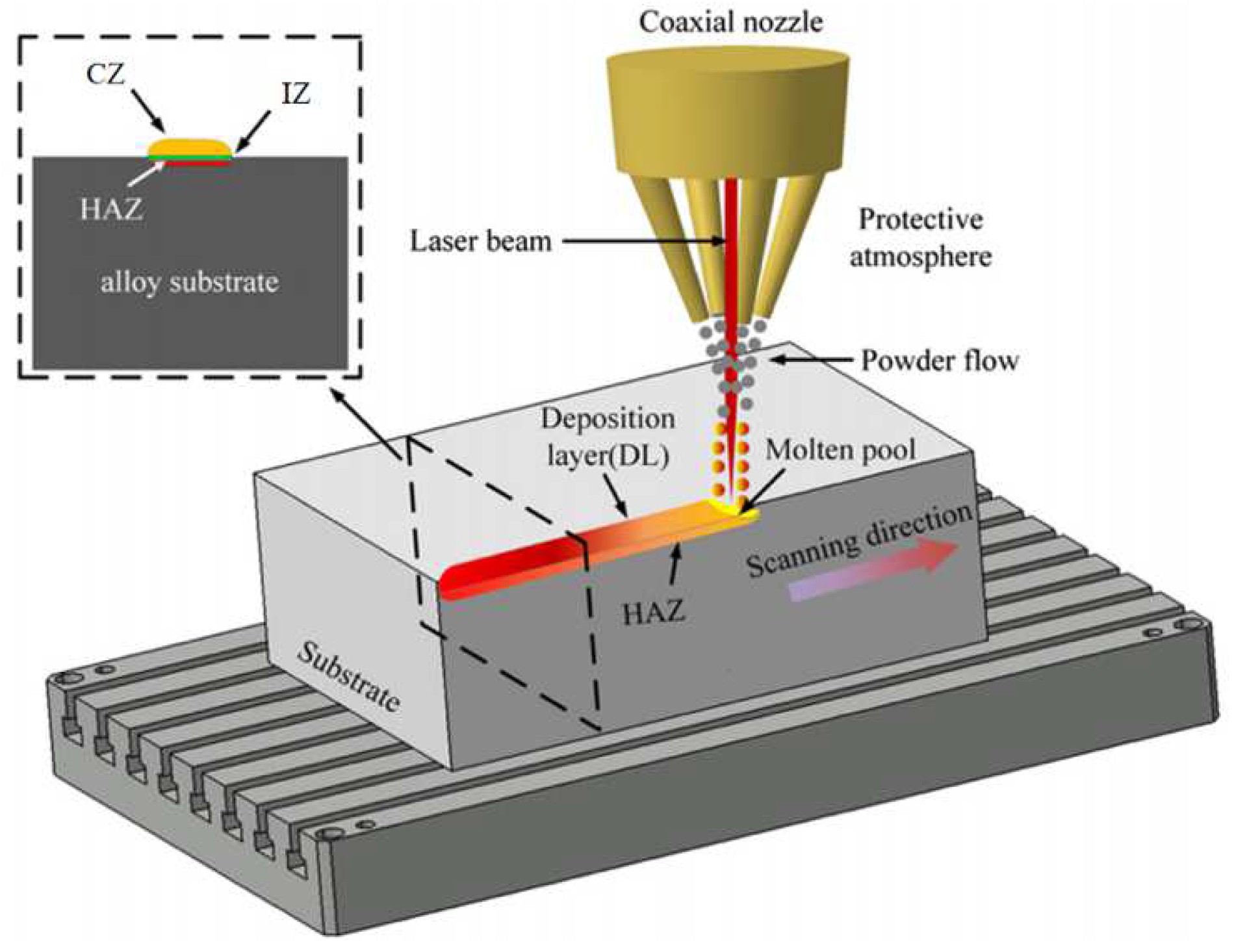
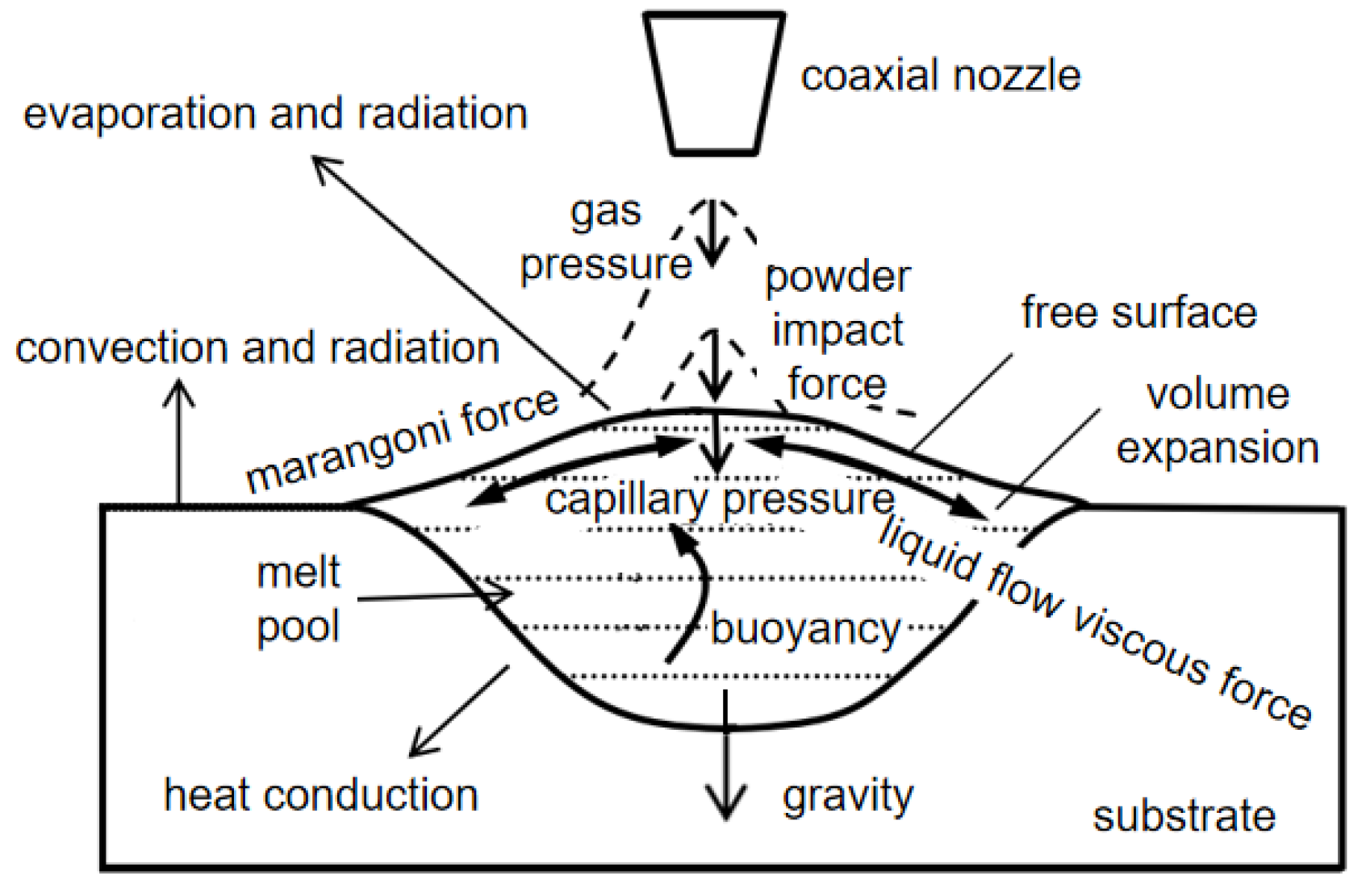

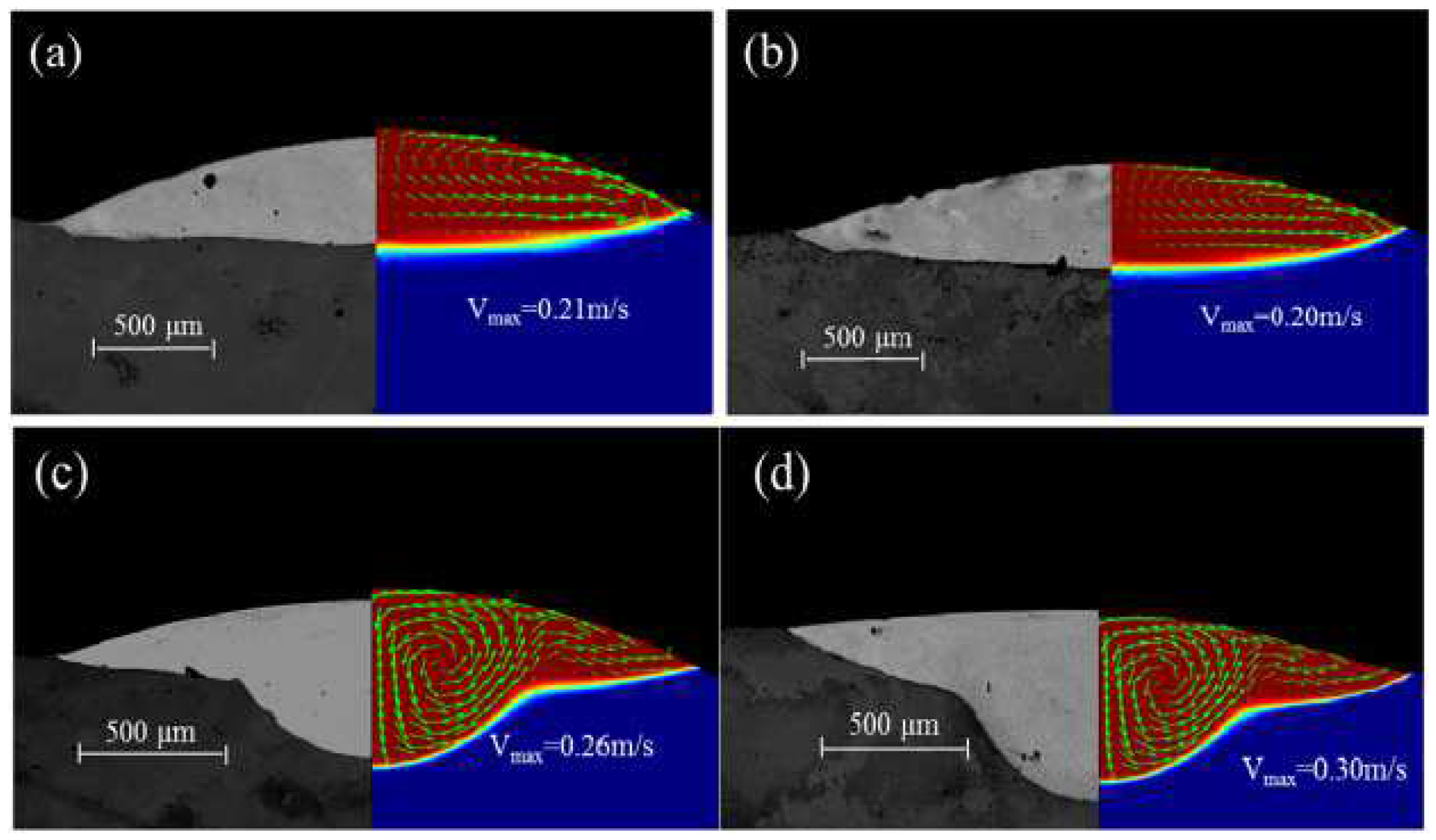
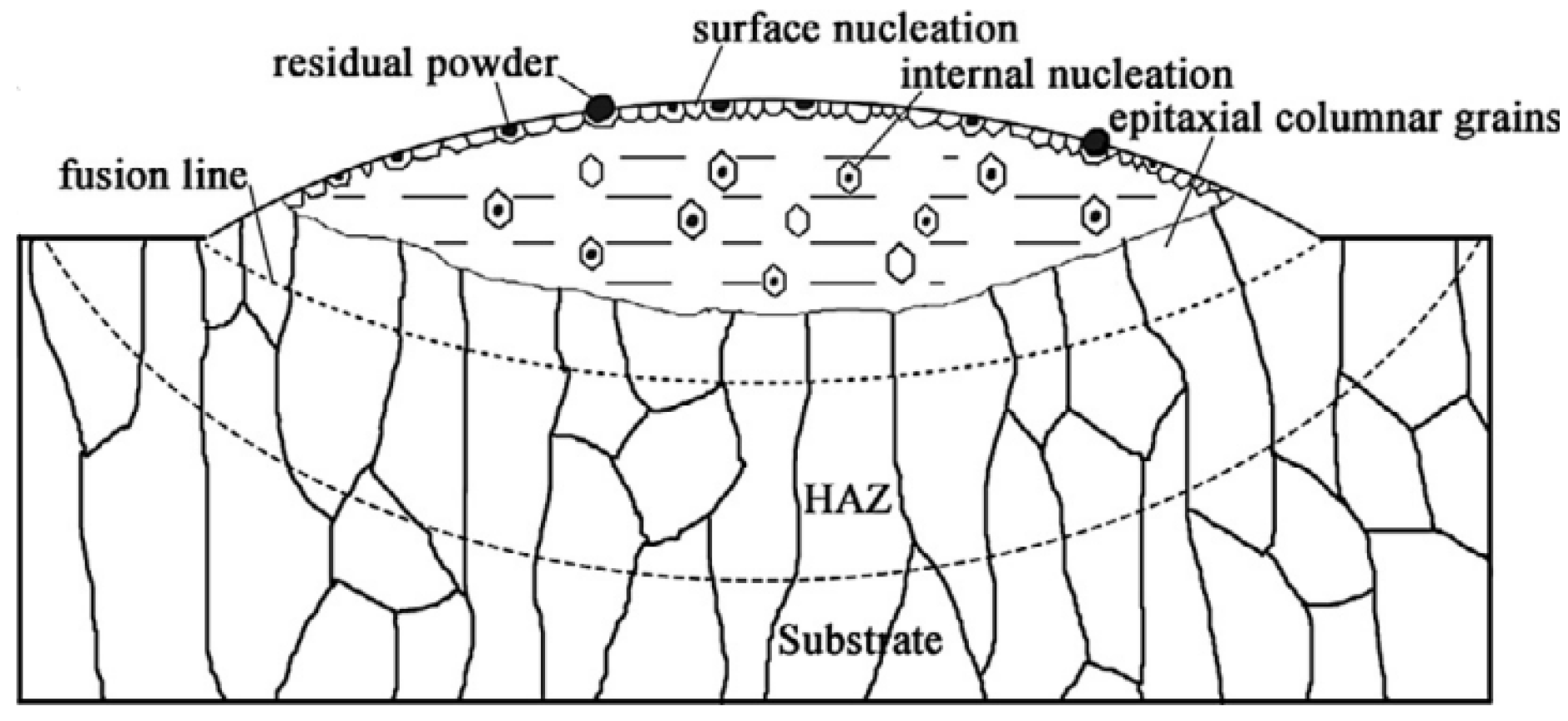

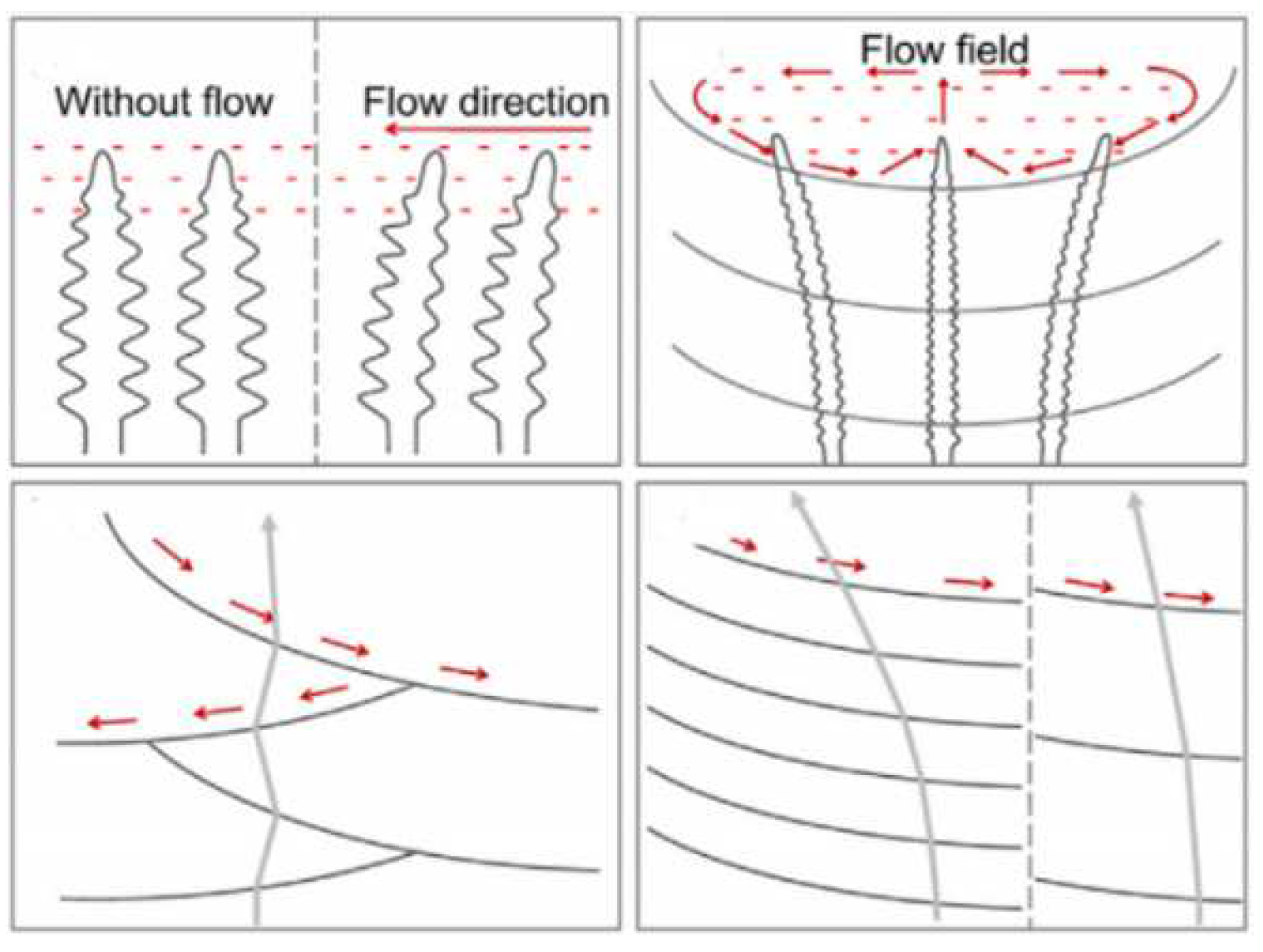

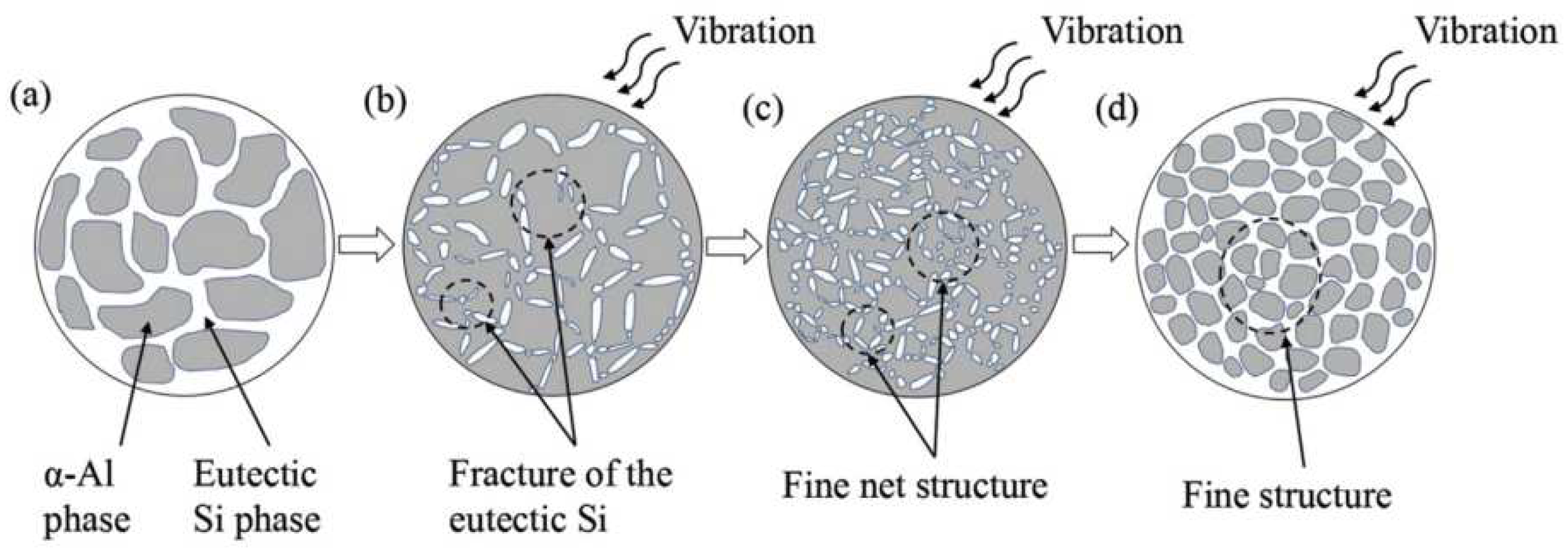
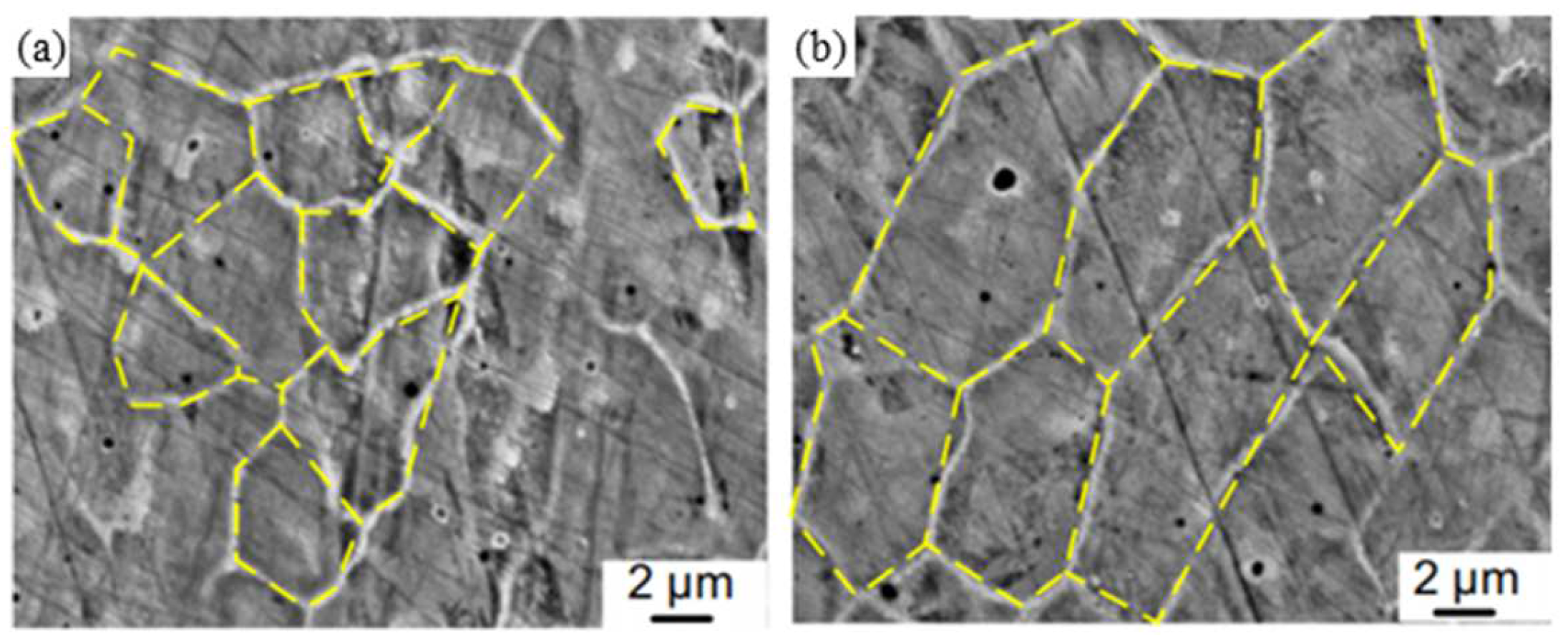
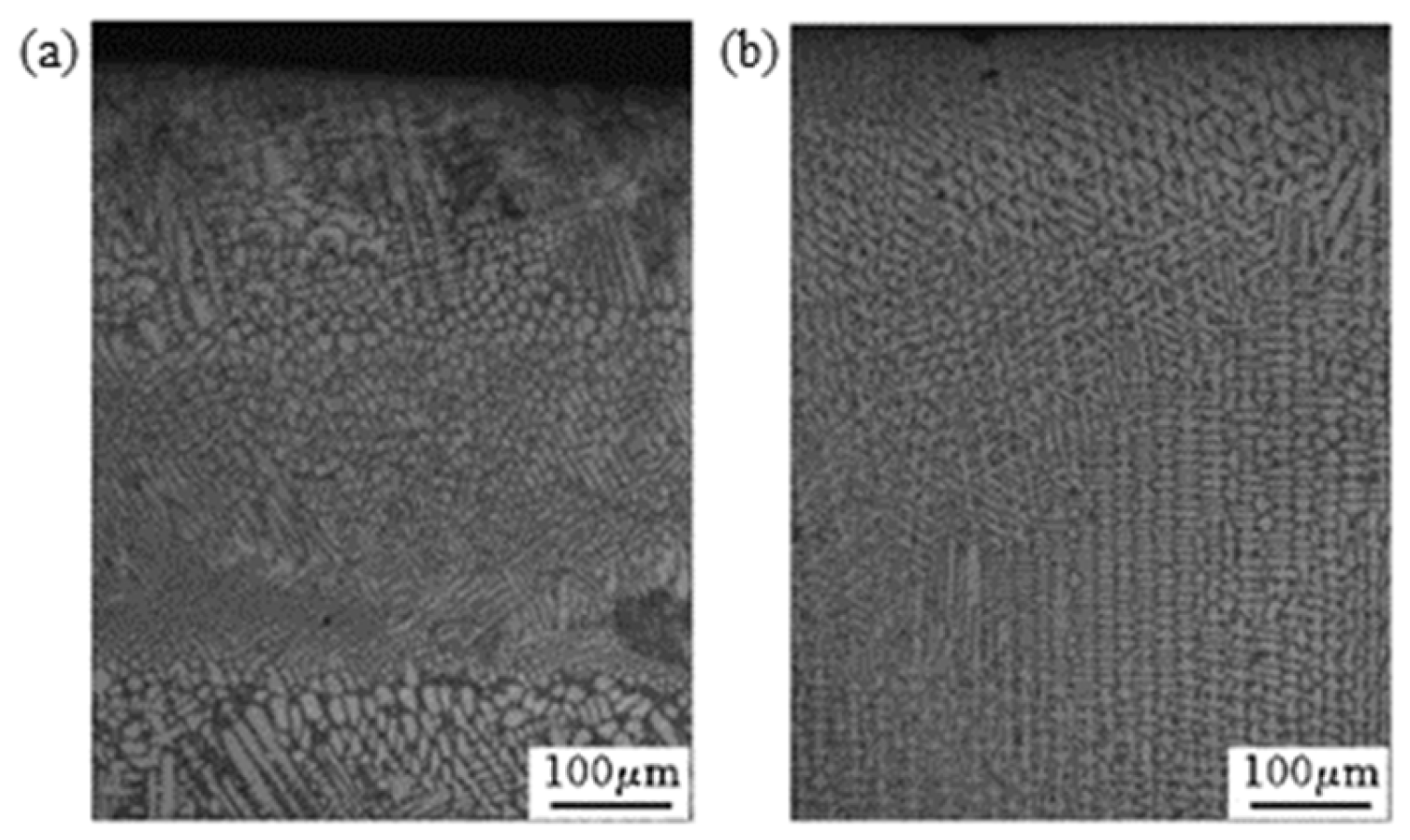


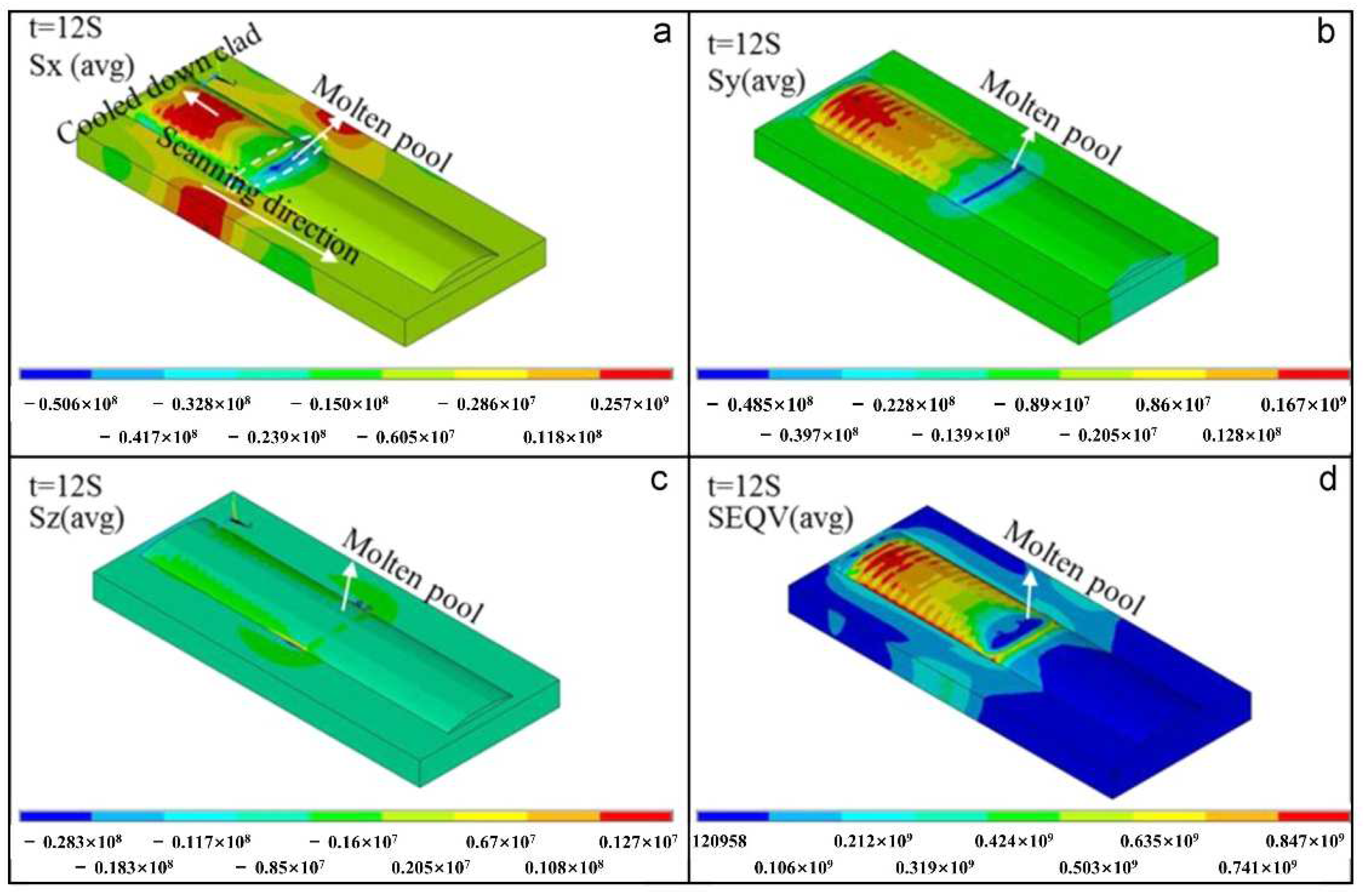
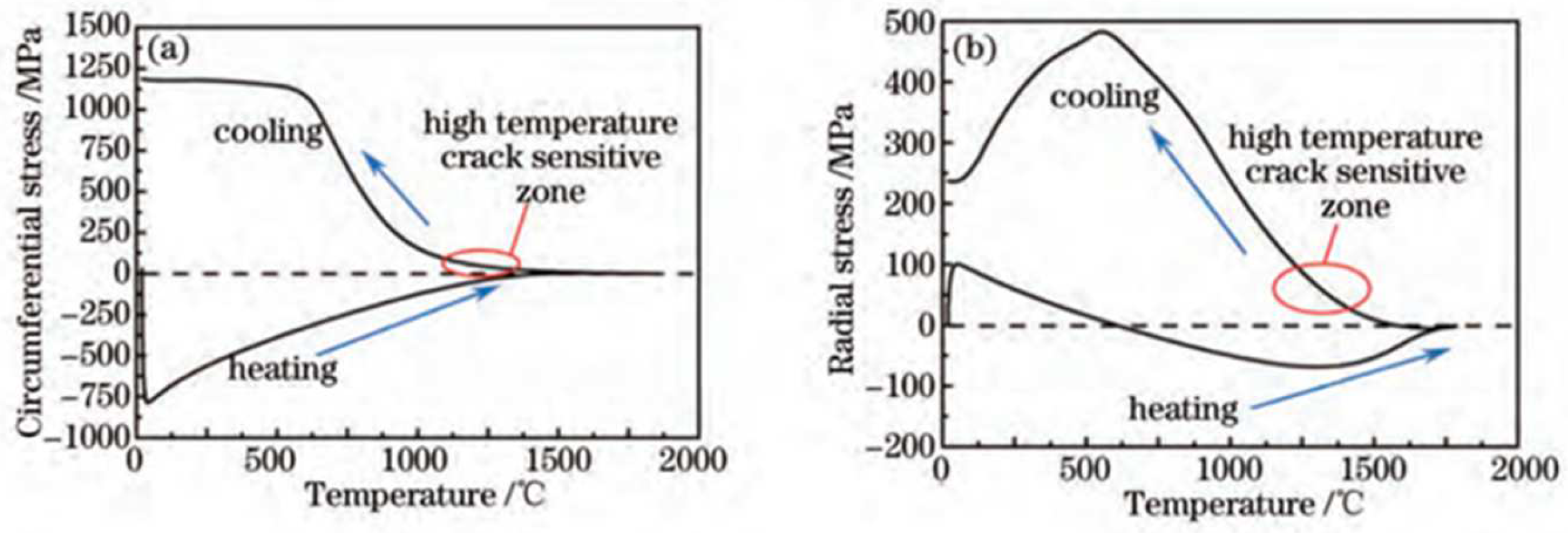


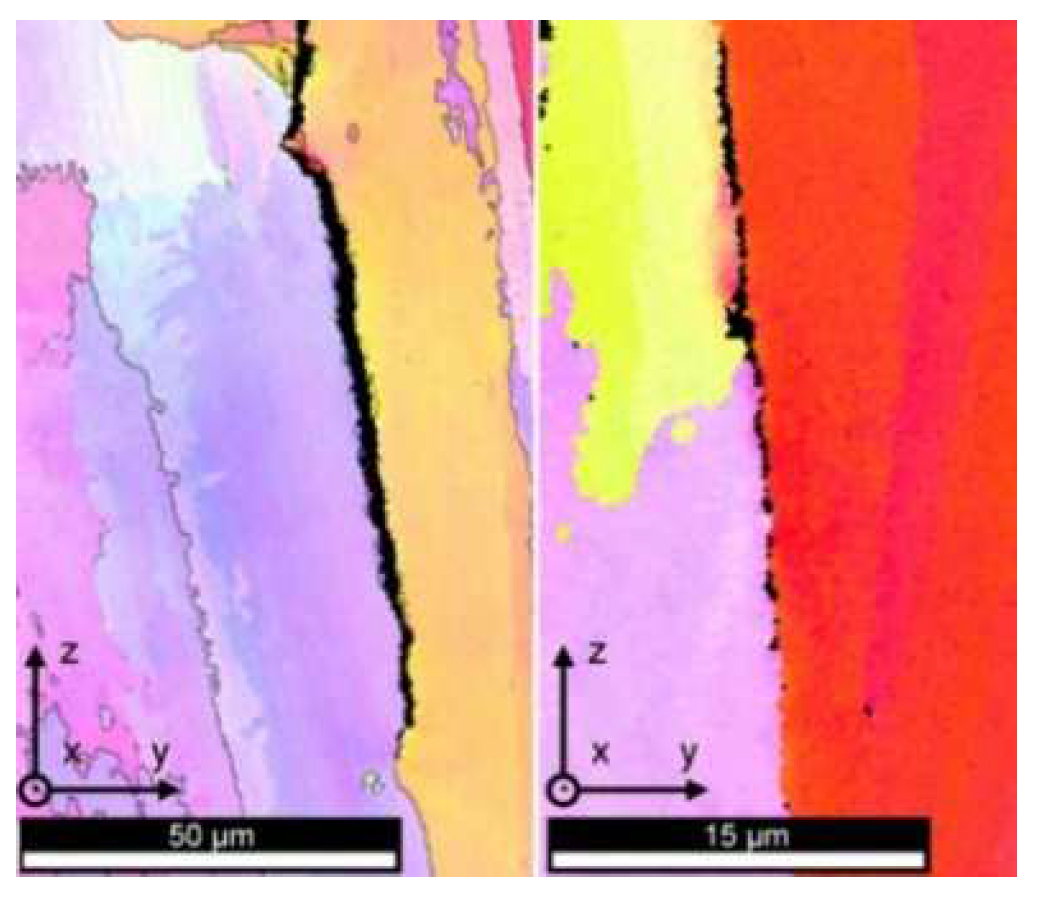

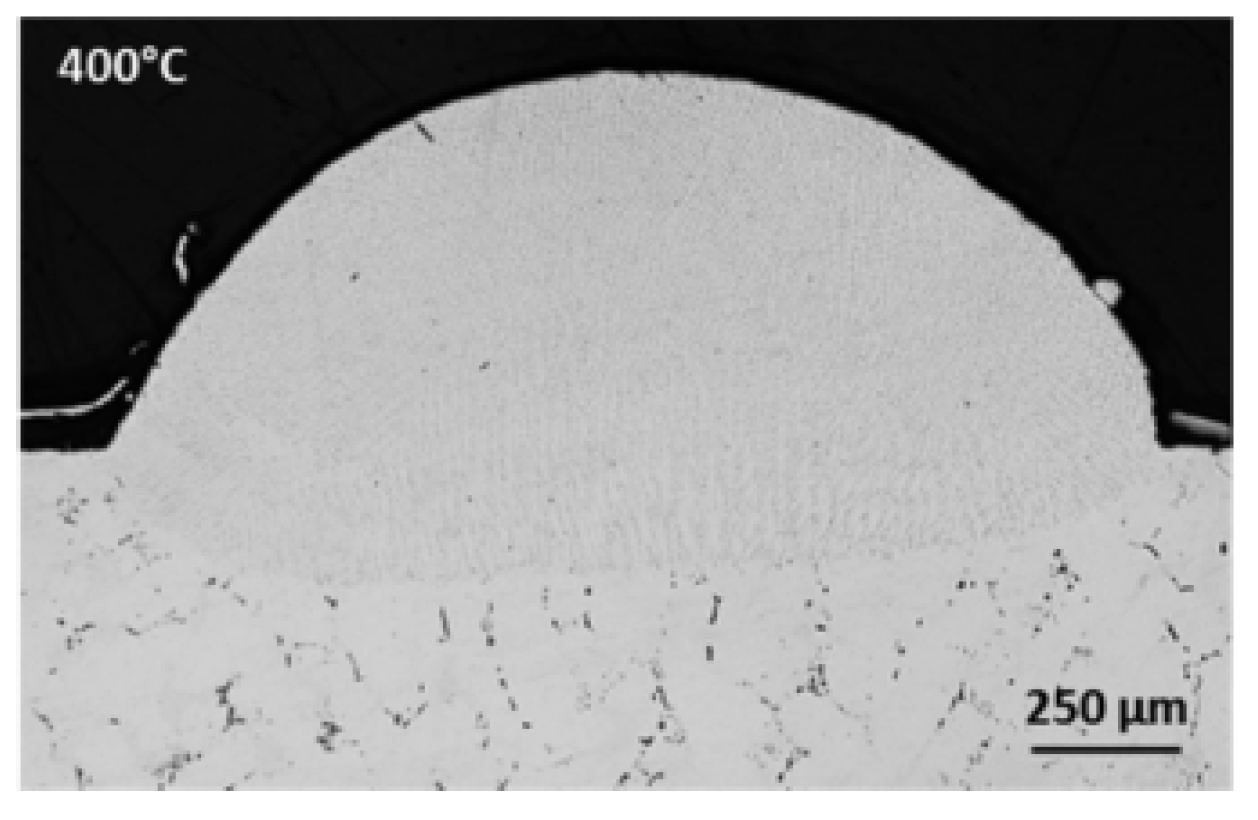


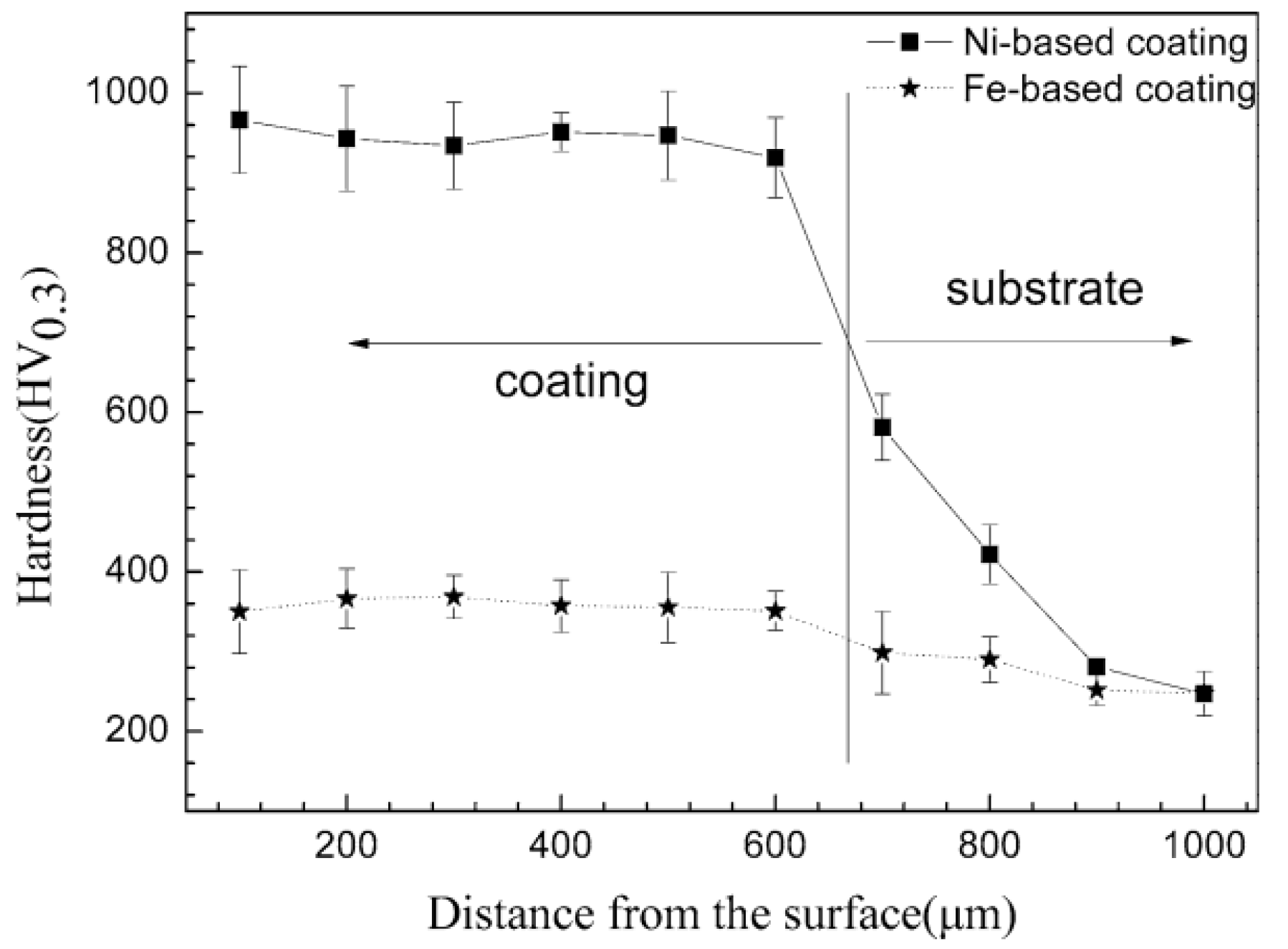
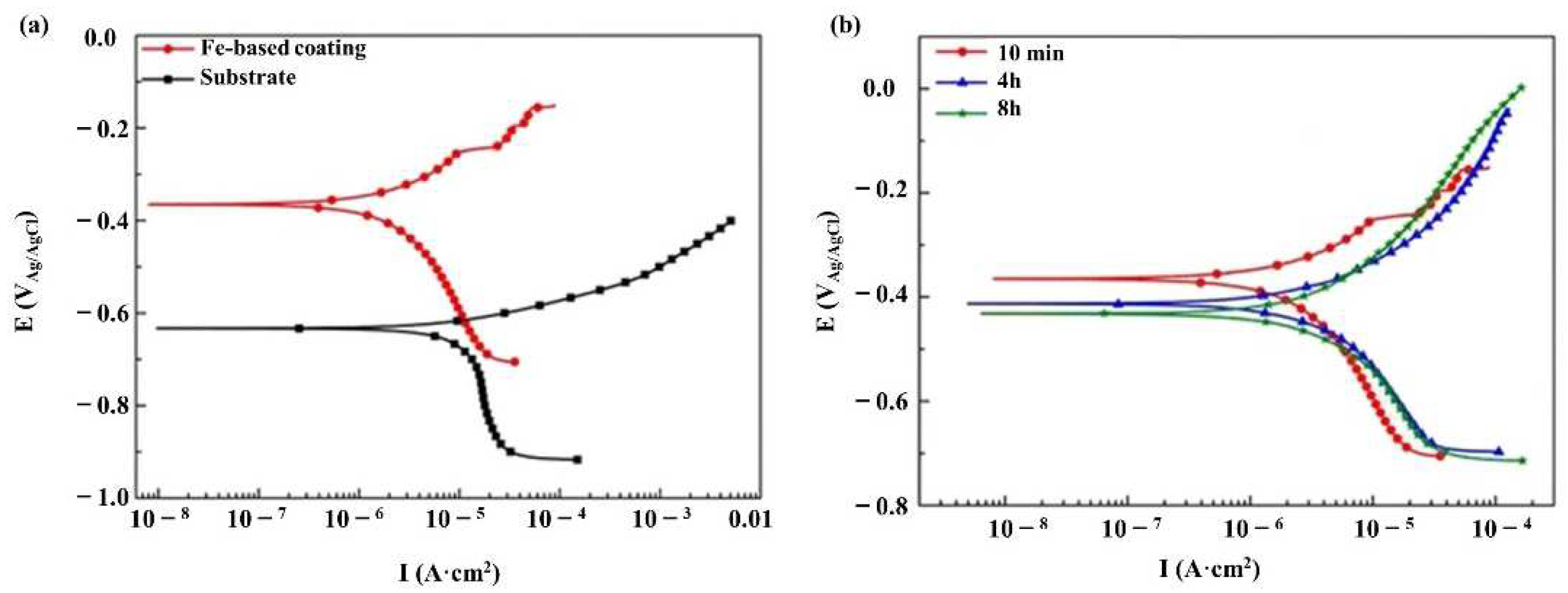
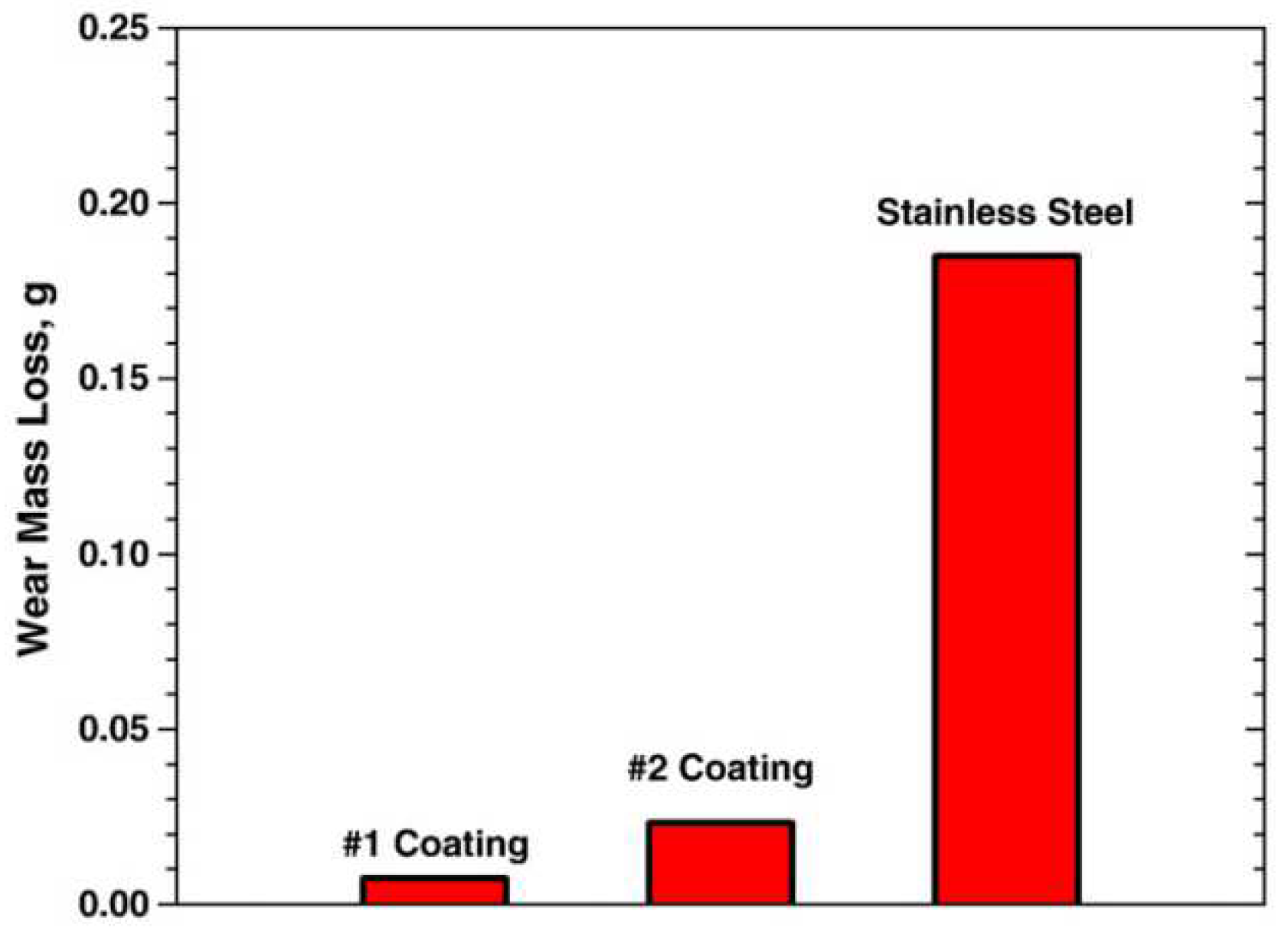
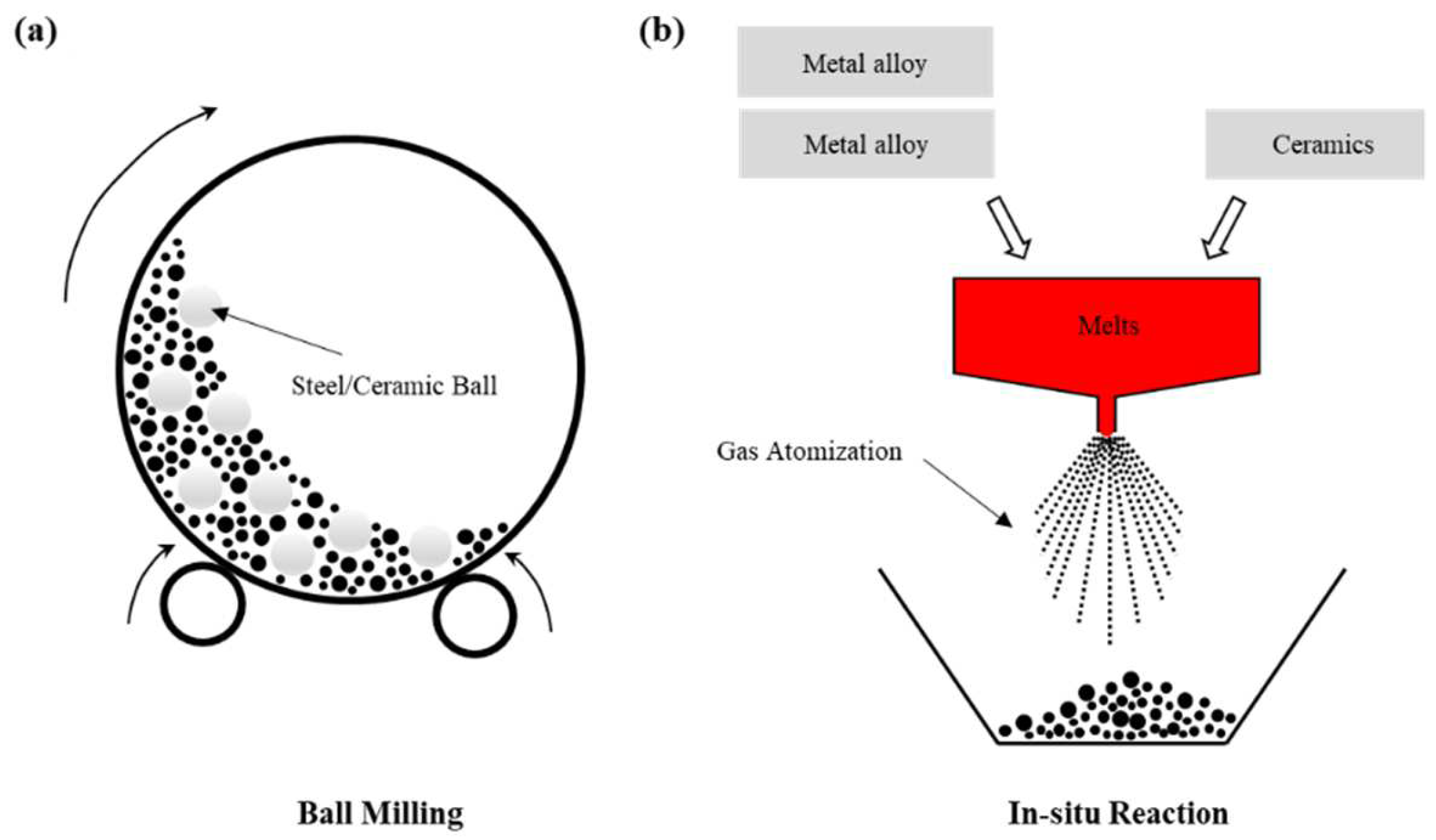


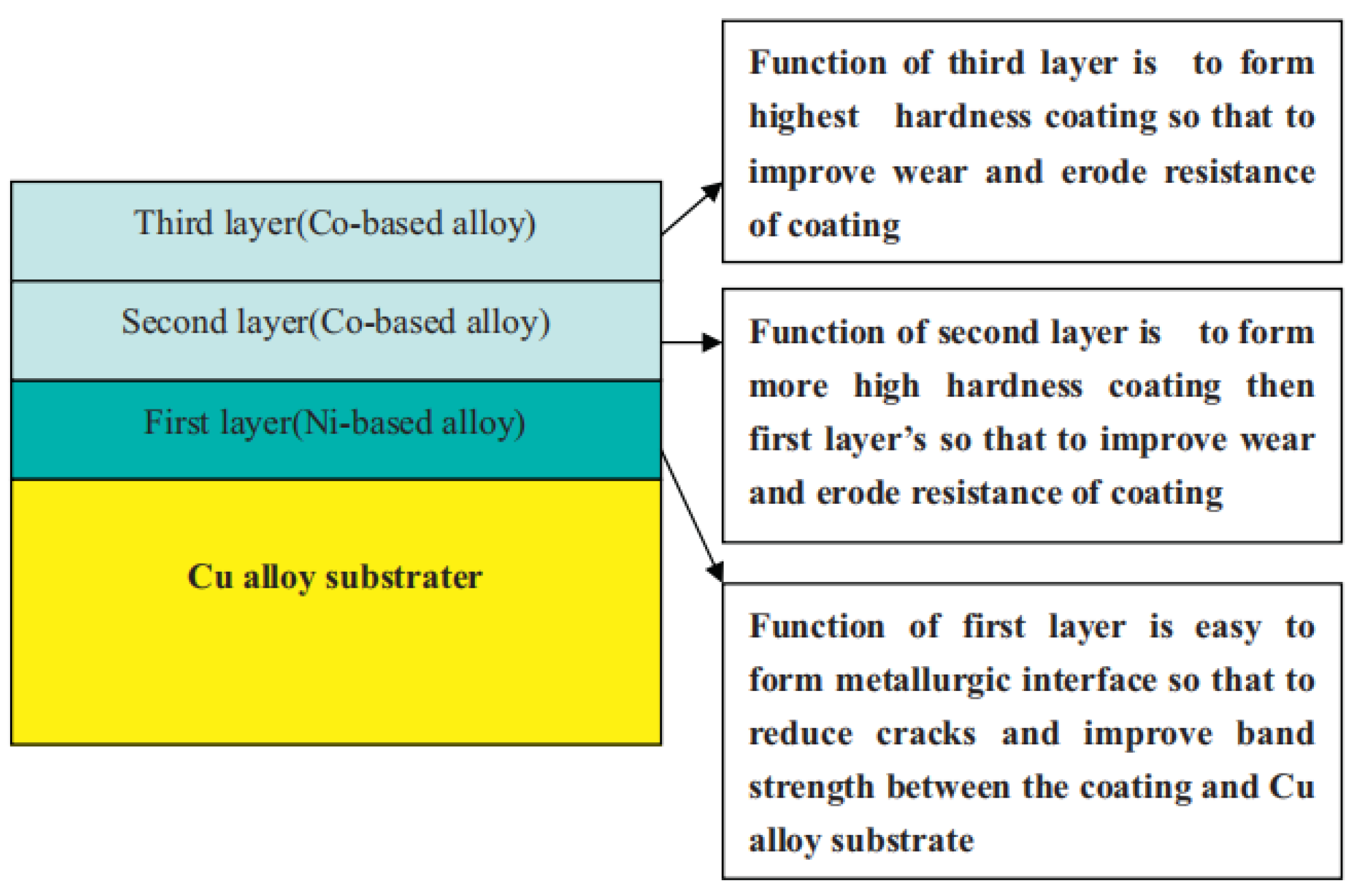
| Coupling Physical Fields | Substrate/Powder | Effects |
|---|---|---|
| High-frequency microvibration [67] | 5025Al/AlSi10Mg&TiC | The grain size has been refined |
| Ultrasonic vibration [68] | Low carbon steel/AISI 630 | Acoustic streaming and cavitation effects transform the microstructure into equiaxed grains. |
| Pulse current [70] | GH4169/FG4169 | Promote grain refinement |
| Strong magnetic field [73] | DZ417G et al. | Fragmentation of cells/dendrites and columnar-to-equiaxed transition |
| Magnetic field [74] | Fe-based alloy/316L | The equiaxed grain area has been significantly enlarged. |
| Alloy Powder | Substrate | References |
|---|---|---|
| Ni-based | Steel, Al alloy, Ti alloy, Cu alloy | [112,113,114,115,116] |
| Fe-based | Steel, Al alloy, Ti alloy, Cu alloy | [118,119,120,121] |
| Co-based | Steel, Ni alloy, Cu alloy | [123,124,125] |
| Cu-based | Steel, Al alloy, Mg alloy | [127,128,129] |
| Additives | Powder Materials | Effects |
|---|---|---|
| TiC-VC [130] | Fe-based alloy | Wear and corrosion resistance increased |
| SiC [131] | Co-based alloy | Microhardness increased by more than 3 times, and the wear resistance is increased by 18.4–57.4 times |
| TiC, TiN and B4C [132] | Ni2O4 | Wear resistance increased |
| La2O3 [58] | Fe-based alloy | Microstructure refined and the wear resistance improved |
| TiC + TiB2 [138] | Ni-based alloy | Wear resistance and microhardness increased |
Publisher’s Note: MDPI stays neutral with regard to jurisdictional claims in published maps and institutional affiliations. |
© 2022 by the authors. Licensee MDPI, Basel, Switzerland. This article is an open access article distributed under the terms and conditions of the Creative Commons Attribution (CC BY) license (https://creativecommons.org/licenses/by/4.0/).
Share and Cite
Cheng, J.; Xing, Y.; Dong, E.; Zhao, L.; Liu, H.; Chang, T.; Chen, M.; Wang, J.; Lu, J.; Wan, J. An Overview of Laser Metal Deposition for Cladding: Defect Formation Mechanisms, Defect Suppression Methods and Performance Improvements of Laser-Cladded Layers. Materials 2022, 15, 5522. https://doi.org/10.3390/ma15165522
Cheng J, Xing Y, Dong E, Zhao L, Liu H, Chang T, Chen M, Wang J, Lu J, Wan J. An Overview of Laser Metal Deposition for Cladding: Defect Formation Mechanisms, Defect Suppression Methods and Performance Improvements of Laser-Cladded Layers. Materials. 2022; 15(16):5522. https://doi.org/10.3390/ma15165522
Chicago/Turabian StyleCheng, Jian, Yunhao Xing, Enjie Dong, Linjie Zhao, Henan Liu, Tingyu Chang, Mingjun Chen, Jinghe Wang, Junwen Lu, and Jun Wan. 2022. "An Overview of Laser Metal Deposition for Cladding: Defect Formation Mechanisms, Defect Suppression Methods and Performance Improvements of Laser-Cladded Layers" Materials 15, no. 16: 5522. https://doi.org/10.3390/ma15165522
APA StyleCheng, J., Xing, Y., Dong, E., Zhao, L., Liu, H., Chang, T., Chen, M., Wang, J., Lu, J., & Wan, J. (2022). An Overview of Laser Metal Deposition for Cladding: Defect Formation Mechanisms, Defect Suppression Methods and Performance Improvements of Laser-Cladded Layers. Materials, 15(16), 5522. https://doi.org/10.3390/ma15165522







